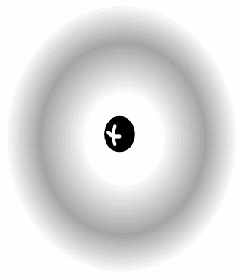Atoms are made up of electrons, neutrons and protons. Electrons and protons are subject to the electric force. If we assume they are point particles of charge![]() and
and![]() respectively, separated by a distance
respectively, separated by a distance![]() – a very good approximations – the magnitude of the electric force between any two of these particles is given by Coulomb's law:
– a very good approximations – the magnitude of the electric force between any two of these particles is given by Coulomb's law:![]() Treating atoms and molecules is point charges however, is highly unsatisfactory. The forces between atoms and molecules are also electric in origin, but atoms and molecules cannot be treated as point charges obeying Coulomb's law. We can treat the nucleus as very nearly a positive point charge because it is only about
Treating atoms and molecules is point charges however, is highly unsatisfactory. The forces between atoms and molecules are also electric in origin, but atoms and molecules cannot be treated as point charges obeying Coulomb's law. We can treat the nucleus as very nearly a positive point charge because it is only about![]() across, but the negatively charged electrons are smeared out around the atom, and the way in which the electrons are smeared out is not constant. We can picture the electrons as a cloud.
across, but the negatively charged electrons are smeared out around the atom, and the way in which the electrons are smeared out is not constant. We can picture the electrons as a cloud.

Sometimes the cloud is concentrated on one side of the atom, sometimes on another. The effect may be to make the atom appear negatively or positively charged depending on the direction from which it is seen. The atom will then attract other atoms which opposite distributions of charge and repel those with similar distributions.
In addition the presence of other atoms of molecules will tend to disturb the distribution of charge on an atom or molecule. If the atoms or molecules are not too close, typically the this will result in mutual attraction, and if they are too close this will result in mutual repulsion. The net effect is that molecules and atoms have an equilibrium separation, about which they settle.
In fact, all chemistry is due to the forces between electrons and electron clouds on different atoms and molcules. Chemical bonds are formed when electrons are shared or transferred between atoms or molecules, and when chemical bonds are broken, electrons are forced to choose which stom they would like to belong to.
